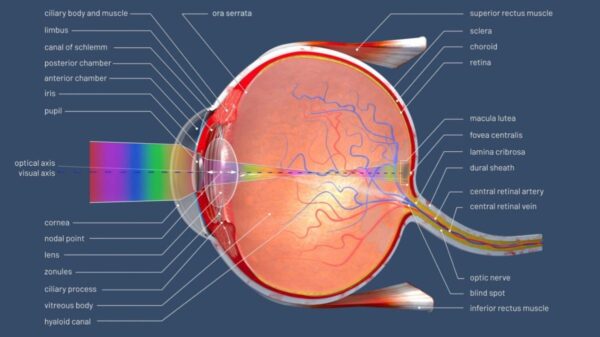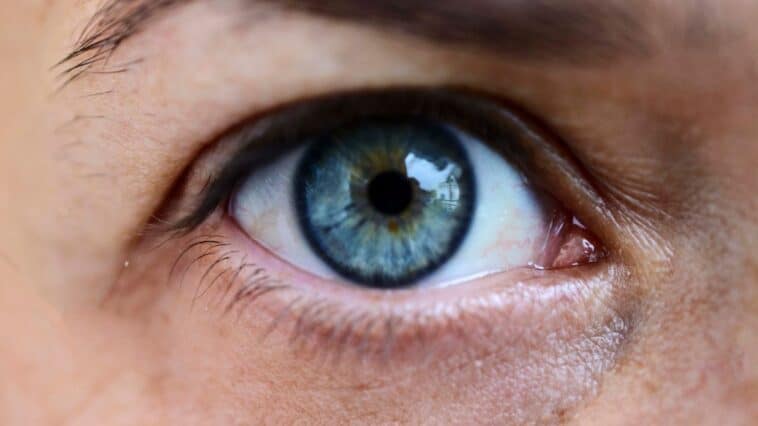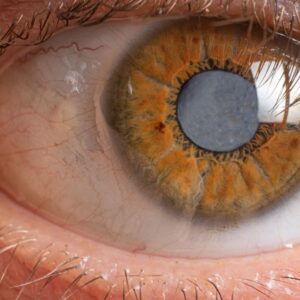What Is the Cornea?
The cornea is the outermost, transparent layer of the eye. It sits at the front of the eye, letting light in and focusing it onto the pupil and iris. This allows us to see clearly.
It is a crucial part of the eye because it helps to focus light as it enters the eye, and it helps to protect the inner structures of the eye from dirt, dust, and other foreign particles.
The cornea comprises several layers of cells and is richly supplied with blood vessels and nerve fibers. It is responsible for about two-thirds of the eye’s total focusing power.
Anatomy of the Cornea
The cornea is composed of several layers, including:
- The epithelium: This is the cornea’s outermost layer and is made up of cells constantly being replaced.
- The Bowman’s layer is a thin, transparent collagen fiber located just beneath the epithelium.
- The stroma: This is the middle layer of the cornea, and it is made up of densely packed collagen fibers that give the cornea its strength and shape.
- Descemet’s membrane is a thin layer found beneath the stroma and serves as the innermost protective barrier of the cornea.
- The endothelium: The cornea is made up of several layers. The innermost layer is known as the endothelium, composed of cells that help keep the cornea clear by expelling extra fluid out of the stroma.
The cornea also contains several other structures, including the corneal nerves, responsible for transmitting sensory information to the brain, and the tear film, which helps keep the cornea moist and healthy.

Cornea Function
The cornea is the clear, transparent structure that covers the front of the eye. It has several vital functions, including:
- Refraction: The cornea helps to focus light onto the retina by bending (refracting) light as it enters the eye.
- Protection: The cornea protects the internal structures of the eye from dust, dirt, and other foreign particles that may enter the eye.
- Sensation: The cornea is richly supplied with nerve endings, which help to transmit sensory information about light and touch to the brain.
- Transparency: The cornea must remain transparent to allow light to pass through and reach the retina.
Overall, the cornea plays a crucial role in vision by helping to focus light onto the retina and protecting the eye’s internal structures.
How Does the Cornea Refract Light?
The cornea refracts light by bending (refracting) the light as it passes through the clear, transparent tissue. The cornea is responsible for about two-thirds of the eye’s total refractive power, with the remainder being provided by the eye’s lens.
The amount of refraction depends on the cornea’s curvature and the tissue’s density. The shape of the front surface of the cornea and the thickness of the cornea determine the curvature of the cornea. A more curved cornea refract light more strongly, while a less curved cornea refracts light less strongly.
The density of the cornea also affects its refractive power. The denser the tissue, the more strongly it will refract light. The cornea comprises several layers of cells, each with a different density. The cells at the front of the cornea are less dense than the cells towards the back, which helps to ensure that the cornea has a consistent refractive power throughout.
What Diseases and Conditions Affect the Cornea?
The cornea is a clear, dome-shaped structure at the front of the eye responsible for refracting light and helping to focus images on the retina. Several diseases and conditions can affect the cornea, including:
- Corneal abrasions are small scratches or cuts on the cornea’s surface, usually caused by trauma or foreign objects.
- Corneal dystrophies: These are inherited conditions that cause the cornea to become cloudy or scarred, leading to vision loss.
- Corneal edema: This is a condition in which the cornea becomes swollen due to excess fluid accumulation, which can cause vision loss.
- Corneal infections: Bacterial, viral, or fungal infections can affect the cornea, causing inflammation, pain, and vision loss.
- Corneal ulcers: These are deep, open sores on the surface of the cornea that infections, abrasions, or other injuries can cause.
- Keratoconus: This is a condition in which the cornea becomes thin and bulges outward, leading to distorted vision.
- Fuchs’ dystrophy: This condition causes the cells in the inner layer of the cornea to die off, leading to vision loss and corneal edema.
- A dry eye is a disorder where the production of tears, or their evaporation, is insufficient to keep the cornea moist, causing irritation and dryness.
Seeing an eye doctor to diagnose and treat these conditions is essential to help preserve your vision.
How Can I Maintain Healthy Vision with Proper Care?
There are several ways you can maintain healthy vision and protect your eyes from potential problems:
- Get regular eye exams: It is essential to have your eyes exams by an eye specialist regularly, even if you don’t think you have any problems with your vision. This can help identify potential issues early on and allow for timely treatment.
- Wear protective eyewear: If you are involved in activities that pose a risk to your eyes (such as playing sports or working with hazardous materials), wear appropriate eyewear to reduce the risk of injury.
- Maintaining a healthy diet is key for the health of your eyes, especially the cornea. Eating plenty of fruits, vegetables, and other nutrient-dense foods can help keep your eyesight sharp by providing your body with essential minerals and vitamins that help protect the cornea.
- Don’t smoke: Smoking can increase the risk of developing various eye diseases, including cornea damage, cataracts, and age-related macular degeneration. These problems can hurt a person’s vision and thus should be avoided.
- Protect your eyes from the sun: UV radiation can harm your eyes, so wearing sunglasses or a hat with a brim is essential outdoors.
- Avoid overworking your cornea: Prolonged exposure to digital screens, like computer and phone displays, can cause your eyes to become strained and tired. Therefore, it’s important to take regular breaks from screens and focus on something else (like a landscape or conversation) in order to give your cornea a break.
These simple steps can help maintain healthy vision and protect your eyes from potential problems.
What Treatments are Available for Corneal Abnormalities?
Treatment for corneal abnormalities will depend on the specific condition and its severity. Some common treatment options for corneal abnormalities include:
- Medications: For infections or inflammation, your doctor may prescribe topical (applied to the eye’s surface) or oral medications to help clear up the problem.
- Lubricating eye drops: If you have dry eye or other conditions that cause eye dryness and discomfort, your doctor may recommend using lubricating eye drops to help moisturize the eye.
- Eye patches: For corneal abrasions or other injuries, your doctor may recommend wearing an eye patch to protect the eye and allow it to heal.
- Corneal transplants: A cornea transplant, known as keratoplasty, is a medical procedure used to restore vision in severely damaged or diseased corneas. A corneal transplant replaces the damaged or diseased cornea with a healthy donor cornea that restores vision.
- Other surgeries: Several other surgical options may be used to treat corneal abnormalities, depending on the specific condition. These may include laser surgery, thermal treatments, or other procedures to reshape the cornea or remove damaged tissue.
It is essential to follow your doctor’s recommendations for treatment and attend all follow-up appointments to ensure your condition is properly managed.
The Role of Orthokeratology for Clear Vision Correction
Orthokeratology, often referred to as “ortho-k,” is an innovative method of improving vision without surgery. It works by reshaping the cornea, the front surface of the eye, which can help reduce or eliminate the need for eyeglasses or contact lenses during daytime hours. Ortho-k consists of wearing special contact lenses while sleeping, which gently and gradually reshape the curvature of the eye’s cornea.
Ortho-k lenses are specially designed to reshape the cornea while you sleep. They are made of gas-permeable materials which allow oxygen to pass through and be delivered directly to the eye. When you wear the lenses during sleep and remove them in the morning, your vision is corrected due to the gentle reshaping of the eye’s front surface.
The effects of the treatment usually last for one to two days, and the process is typically repeated every night until the desired level of vision correction is achieved.
Ortho-k is generally considered a safe and effective treatment for correcting vision in people with myopia (nearsightedness) or astigmatism. However, it is not suitable for everyone and is generally not recommended for people with severe vision problems or certain medical conditions.
Ortho-k, or orthokeratology, is an eye care treatment that aims to reshape one’s cornea with specially designed contact lenses. To determine if this treatment is suitable for you, getting a comprehensive eye exam and consultation from an experienced professional is essential, so your risks and benefits can be weighed out.






